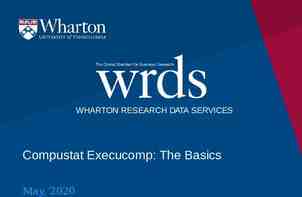ENVIRONMENTAL HEALTH AND SAFETY HAZARDOUS WASTE TRAINING
36 Slides8.26 MB
ENVIRONMENTAL HEALTH AND SAFETY HAZARDOUS WASTE TRAINING
“Why do we have to take this class?” It’s the Law and for your safety! “How often do I take this training?” Annually 03/16/2023
Hazardous Waste training is an ANNUAL requirement. Please plan on attending this training again or take the online refresher within one year of today’s date if you are still working in a lab and may be handling hazardous waste. Training options: Training class Online refresher https://sc.edu/about/offices and divisions/ehs/index.ph p 03/16/2023
Items covered in this training: Regulations for Hazardous Waste What is a Waste? Making a Waste Determination / Universal Waste / NonRegulated Waste Satellite Accumulation Area Requirements Waste Management in the Labs Spills – Who is responsible and what to do Waste Pick-up Procedure What happens when my lab is not compliant? Quiz 03/16/2023
Regulation of Hazardous Waste Who Regulates the University? RCRA- Resource Conservation and Recovery Act (overseen by EPA) is the public law that creates the framework for the proper management of hazardous and non-hazardous solid waste. The law describes the waste management program mandated by Congress that gave EPA authority to develop the RCRA program. Enacted in 1976. EPA - Environmental Protection Agency (est. 1970) Born in the wake of elevated concern about environmental pollution, EPA was established to consolidate in one agency a variety of federal research, monitoring, standard-setting and enforcement activities to ensure environmental protection. Since its inception, EPA has been working for a cleaner, healthier environment for the American people 03/16/2023
Regulations for Hazardous Waste (cont.) Who Regulates the University? SCDHEC- is charged with upholding the requirements in the Solid Waste Policy and Management Act, meaning that at least once every five years, the DHEC shall review each permitted facility. They inspect facilities and files. They enforce compliance for the best interest of the health of the people and the environment of SC. D.O.T. – Department of Transportation is a cabinet-level agency of the federal government responsible for helping maintain and develop the nation’s transportation systems and infrastructure. From roads to airlines to railways, DOT carries out planning that supports the movement of Americans by cars, truck, trains, ships and planes. 03/16/2023
What is a Waste? A waste is ANY solid, liquid or contained gaseous material that: Is beyond it’s expiration date OR Is no longer viable for it’s intended purpose and is to be discarded 03/16/2023
What is a Hazardous Waste? Listed Hazardous Waste D-Listed – Waste that has a hazardous characteristic F-listed – Non-specific source wastes (Ex. - Spent solvents) K-listed – Specific-source wastes (Generally not generated by the University) P-listed & U-listed – Unused Commercial Chemical Products Special Exception for P-Listed Chemicals: Empty 03/16/2023 containers that held p-listed chemicals must be
What is a Hazardous Waste? (cont.) Characteristic Hazardous Waste (D-Listed) Ignitable (D001) – Ignitable wastes include oxidizers and liquid, solids and gases that have a flashpoint of 140 F Corrosive (D002) – Reactive (D003) – Toxic (D004-D043) – pH 2 (acidic) or pH 12.5 (basic) Water or air reactive waste that produces toxic fumes threaten 03/16/2023 Materials that potentially human and/or wildlife health
What is a Hazardous Waste? (cont.) 03/16/2023
Universal Waste and Non-regulated Waste Universal Waste – Includes all mercury containing devices. Must be tagged and disposed of through the USC HW Program as Universal Waste Broken devices must be cleaned up immediately, tagged and disposed of as hazardous waste Non-Regulated Waste – May be disposed of in regular trash 03/16/2023 Empty containers Broken glass Non-contaminated PPE and glassware
Waste Management in Satellite Accumulation Areas (SAA) (i.e. – Laboratories) Requirements for SAA’s 03/16/2023 Waste container must be at or near the point of generation of the waste Waste container must be properly labeled Waste container must be closed at all times except for when adding waste No more than 55 gallons of waste may be stored at any time. Waste determination must be made a point of
Container Types Container must be compatible with contents Containers must be capable of closing No corks, stoppers, foil, or parafilm No glass containers Completely deface all old labels if reusing containers USC EH&S provides HDPE 10L carboys, 4L, 1000mL, 500mL, and 5-gallon buckets 03/16/2023
03/16/2023
Making a Hazardous Waste Determination The waste determination must be made at the point of generation (i.e. – Lab or shop) All chemical constituents and amounts (%, ppm, mL) must be known and included on the USC waste tag All chemical hazards must be known and included on the waste tag Check Safety Data Sheets (SDS) for chemical hazards and compatibilities HAZARDOUS WASTE MAY NOT BE 03/16/2023 DILUTED TO RENDER IT NON-
Hazardous Waste Container Labeling All hazardous waste containers must be labeled with the following: 03/16/2023 The words “Hazardous Waste” All chemical constituents (Only technical names. No chemical formulas (C3H6O) or trade names. This is the USC waste tag provided by USC EH&S. Indicate all chemical hazards of the waste in the container
USC Pre-printed Waste Labels 03/16/2023
Off-Spec Waste / Rejected Waste Off-spec waste will not be picked up ex. Unlabeled container Glass container Incorrect constituents Missing information A rejection sticker will be placed on any offspec container and the container will be left in the lab. Email the HW Manager once the issue has been corrected and your container will be picked up. 03/16/2023
What’s wrong? Hint, look at obvious 03/16/2023
What’s wrong? What makes it acidic? Does it equal 100%? 03/16/2023
What’s wrong? Hint, look at obvious 03/16/2023
What’s wrong? Abbreviations DO NOT DO IT!! What is “AA waste and ICP waste” Who does this belong to? Building? Totals? What makes it Acidic? 03/16/2023
Chemical Spills / Housekeeping Ensure that all waste is handled cautiously The laboratory is responsible for cleaning up all spills Spills must be cleaned up immediately Spilled materials that are contaminated with hazardous waste must be handled as hazardous waste Ex. - Gloves, towels absorbent material, etc. It is not the responsibility of custodial 03/16/2023
03/16/2023
Waste Pick-up Procedures Requests must be made through the USC Hazardous Waste Database The database can be found at: https://sc.edu/about/offices and divisions/ehs/ index.php Waste pick-ups are every Wednesday Requests must be made before noon on the Tuesday prior for the waste to be picked up the following day 03/16/2023
03/16/2023
03/16/2023
03/16/2023
03/16/2023
Fill form out for each container. Each container must have its own tag. EH&S track each container from “Cradle to grave” 03/16/2023
Waste Minimization Do not mix hazardous and non-hazardous waste Do not buy chemicals in bulk, when possible 03/16/2023
Consequences of Regulatory Noncompliances If your lab is cited for regulatory noncompliances that result in a monetary fine, your Department is responsible for paying the civil penalty Civil penalties can result in up to 25,000 per violation per day. 03/16/2023
HW Competency Quiz and Certificate In order to obtain your certificate for this class you must take the HW quiz online located on the EHS website. https://sc.edu/about/offices and divisions/ehs/ index.php 20 Questions 80% or greater is a passing grade Certificate will be available to print immediately Ensure a copy of your training certificate is 03/16/2023 placed in your lab’s Chemical Hygiene Plan
In Case of Emergency Campus Emergency Number 777-9111 EH&S 777-5269 Chemical Spills – Call EH&S 777-5269 Ensure your lab has a fire extinguisher If bodily injury occurs, call 777-9111 immediately or go to Thompson Student Health Center 03/16/2023
Please visit the USC EH&S website @ https://sc.edu/about/offices and divisions/ehs/ index.php If you have any questions or need any additional information, please contact: Jeff Brannon – USC Hazardous Waste Manager University of South Carolina EHS Office 226 Bull St., Office 301-E [email protected] (803)777-1935 03/16/2023
Thank you and be safe!!!! 03/16/2023







